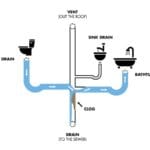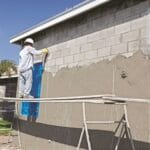A leaking roof can turn your cozy home into a stressful situation. You hear the constant drip, see the stains forming on your ceiling, and worry about the damage spreading.
But here’s the good news: you don’t always have to rush to fix it from the outside. You can tackle it from inside your home, saving time and avoiding external obstacles like bad weather. Imagine feeling the relief of stopping the leak quickly and efficiently, right from where you are.
In this guide, you’ll discover simple steps that empower you to take control, using tools you likely already have. By the end, you’ll know exactly how to protect your home and bring peace back to your space. Dive in, and turn frustration into action!
Identifying The Source Of The Leak
Identifying the source of a leak in your roof can be a daunting task, especially from the inside. Yet, understanding exactly where the water is coming from is the first crucial step in any repair process. Without pinpointing the origin, you might only be addressing the symptoms rather than the root cause. Let’s dive into some clear indicators and necessary tools to make your inspection effective.
Signs Of A Leaking Roof
Have you noticed water stains on your ceiling? These brown, circular marks are often the first sign of a leak. Pay attention to any musty smells or damp patches, as they may indicate hidden water damage.
Check the walls for peeling paint or wallpaper. These could be caused by moisture seeping in from above. Also, listen for dripping sounds when it rains—this could be a clue pointing to the leak’s location.
Sometimes, the presence of mold or mildew in your home can signal a leak. Mold thrives in moist environments, so its appearance often suggests water intrusion.
Tools Needed For Inspection
Before you begin your inspection, gather a flashlight. A bright light will help you see into dark corners and crevices. It’s especially useful for spotting small holes or cracks.
A pair of binoculars can be surprisingly helpful, allowing you to examine the roof’s surface from the ground. Look for missing shingles or damaged flashing that might be causing the leak.
Consider using a moisture meter. This device can measure the humidity levels in your walls and ceiling, indicating areas that may be damp but not visibly wet.
What strategies have you tried in the past to identify leaks? Sometimes, approaching the problem with fresh eyes—or tools—can reveal hidden issues.
Remember, addressing the source is key. While patching up visible damage might seem like a quick fix, ensuring you tackle the underlying problem will save you time and money in the long run.

Credit: northeastplumbing.com.au
Temporary Fixes For Leaking Roofs
Finding a leak in your roof can be a nerve-racking experience. You might wonder if you need to replace the entire roof or if there’s a quick fix to stop the water from pouring in. Luckily, there are temporary fixes you can try from the inside that might save your day. These solutions are not permanent, but they can keep the water at bay until you can arrange for professional help. Let’s dive into a couple of practical methods that you can easily manage on your own.
Using Tar And Patching Compounds
Have you ever tried patching a hole in your clothes? A similar concept applies to fixing leaks in your roof. Tar and patching compounds can serve as a quick fix for pesky leaks. You’ll need to identify the wet spot first. Once found, clean the area thoroughly and apply roofing tar directly over it. The tar acts as a barrier against water and seals the leak temporarily. Follow this up with a patching compound to ensure stability. It’s like adding an extra layer of protection. Remember, this is a temporary measure. It buys you time to call in the experts.
Applying Roofing Tape
Roofing tape is another handy tool in your arsenal against leaks. This tape is designed to withstand harsh weather and provide a strong seal. Picture it as a bandage for your roof. Start by cleaning the affected area. Dirt and debris can prevent the tape from sticking properly. Once clean, apply the tape over the leak. Press firmly to secure it in place. The tape provides immediate relief by stopping water from seeping through the roof. It’s not a permanent solution, but it’s effective in an emergency. Have you ever thought about how a simple roll of tape could save your home from water damage?
Temporary fixes give you peace of mind and allow you to act quickly. Have you tried any of these methods before? They might seem simple, but sometimes simplicity is just what you need. What’s your go-to strategy when you spot a leak in your roof? These solutions empower you to take action and protect your home from further damage.
Sealing And Waterproofing Techniques
Fixing a leaking roof from the inside involves using sealing and waterproofing techniques. Locate the leak, then apply a quality sealant to stop water entry. Ensure complete coverage to prevent future leaks.
Sealing a leaking roof from the inside requires practical techniques to ensure your home remains dry and cozy. While it might seem like an outdoor problem, addressing leaks from within can provide a temporary fix, especially during harsh weather when accessing the roof is challenging. Let’s dive into some effective sealing and waterproofing methods you can use to tackle this issue.Using Silicone Sealant
Silicone sealant is a versatile tool in your leak-fixing arsenal. It’s easy to apply and highly effective at sealing gaps and cracks. First, identify the leak’s location by looking for water stains or damp areas. Once you’ve pinpointed the trouble spot, clean the area thoroughly. Any dirt or moisture can prevent the sealant from sticking properly. Apply the silicone sealant generously over the crack or gap. Ensure you smooth it out to cover the area evenly. One winter, I faced a similar situation. A leak above my living room threatened to ruin our holiday cheer. Applying silicone sealant provided an immediate relief, holding up until we could tackle the problem from the outside. Have you ever tried using silicone sealant? How did it work for you?Spray Foam Application
Spray foam is another effective method to stop a leak from the inside. It expands to fill gaps, making it ideal for sealing larger leaks. Before you begin, shake the can thoroughly to ensure the foam expands properly. Spray the foam into the leaking area, starting from the edges and moving inward. This technique ensures the foam fills the gap completely. Allow it to expand and cure as per the instructions on the can. I remember using spray foam in my attic during a rainy season. The foam not only stopped the leak but also added a layer of insulation. It’s a quick fix that can save you from further water damage. What are your thoughts on using spray foam for such repairs? Addressing a leaking roof from the inside might seem daunting, but with the right techniques, you can protect your home and buy yourself some time to plan a more permanent solution. Have you encountered any other effective methods for sealing leaks?
Credit: www.youtube.com
Safety Precautions And Tools
Fixing a leaking roof from the inside requires careful attention. Safety should always be your first priority. Proper gear and tools make the task easier and safer. This section provides valuable insights on what you need.
Protective Gear
Wearing the right protective gear is crucial. Begin with a sturdy pair of gloves. These will protect your hands from sharp edges. Safety goggles are essential too. They shield your eyes from dust and debris.
Non-slip shoes are important. They provide stability on wet surfaces. Consider a hard hat for extra safety. It protects your head from unexpected bumps or falls.
Essential Tools For Roof Repair
Having the right tools simplifies the repair process. A flashlight is vital. It helps you see clearly in dim areas. Use a bucket to catch dripping water. This prevents further damage indoors.
A utility knife is handy for cutting damaged sections. Keep a roof patch kit nearby. It’s useful for quick fixes. A trowel helps spread patching material evenly.
Lastly, don’t forget a sturdy ladder. It offers safe access to the roof area. Ensure it’s stable before climbing.
When To Call A Professional
Consider calling a professional when the leak becomes severe or if there’s extensive damage. Attempting repairs on your own might worsen the situation. Professional help ensures proper and safe repairs.
Dealing with a leaking roof can be stressful, especially when you’re not sure whether you can handle the repair yourself. It’s important to know when to call a professional to prevent further damage. You don’t want to risk a small leak turning into a bigger problem. Understanding the signs that it’s time to bring in an expert can save you time, money, and a lot of frustration.Assessing Damage Severity
First, evaluate how serious the leak is. If you notice water stains spreading across your ceiling, it might be more than a simple fix. Check for signs of mold or a musty smell. These indicate that water has been seeping in for a while. If you see sagging in the ceiling, it’s a red flag. This suggests that the structure underneath could be compromised. You might need more than a DIY patch-up. A professional can provide a thorough assessment.Benefits Of Professional Repair
Hiring a professional can bring peace of mind. They have the right tools and expertise to fix the issue properly. This minimizes the risk of future leaks. I remember a friend who thought fixing a small leak was easy. But the problem came back worse, costing more to repair in the end. Professionals can also spot hidden issues that an untrained eye might miss. They ensure the repair is done safely, especially if your roof is high or steep. It’s not just about fixing the leak, but ensuring your home remains safe and sound. When you call a professional, you’re investing in a long-term solution. Have you considered how much time and effort you could save? Sometimes, the best DIY is knowing when to rely on experts.Preventive Measures For Future Leaks
Fixing a leaking roof is crucial. But preventing future leaks is equally important. Implementing preventive measures can save you from costly repairs. Regular maintenance keeps your roof in top condition. Protect your home by taking these steps.
Regular Roof Inspections
Inspect your roof at least twice a year. Check for missing or damaged shingles. Look for signs of wear and tear. Early detection of problems prevents bigger issues later. Pay attention to the roof’s surface and flashing. Secure any loose materials immediately.
Hire a professional for a thorough inspection. They can spot hidden problems. This ensures nothing is overlooked. Regular inspections extend the lifespan of your roof.
Maintaining Gutters And Downspouts
Keep gutters and downspouts clean. They direct water away from your roof. Clogged gutters cause water to pool. This can lead to leaks. Remove leaves and debris regularly.
Check for signs of rust or damage. Repair any issues promptly. Ensure downspouts are directing water away from the foundation. This prevents water damage to your home’s structure. Well-maintained gutters and downspouts protect your roof investment.

Credit: theroofdoctor.com.au
Frequently Asked Questions
How Can I Temporarily Fix A Leaking Roof?
Apply a roof patch with a tar-based product. It seals leaks temporarily.
What Tools Do I Need For An Inside Roof Repair?
You’ll need a bucket, roofing tar, a putty knife, and a flashlight.
Is It Safe To Fix A Roof Leak During Rain?
Fixing during rain is risky. Work inside only. Use caution.
Can I Fix A Leaking Roof Without Professional Help?
Yes, minor leaks are manageable. Follow safety precautions and simple steps.
What Causes A Roof To Leak From The Inside?
Damaged shingles, cracked flashing, or improper sealing often cause leaks. Inspect regularly.
Conclusion
Fixing a leaking roof from the inside can be manageable. Quick action prevents further damage. Start with locating the leak source. Use a patch or sealant for temporary repair. This buys you time until a full fix. Remember, safety is crucial when working indoors.
Consider professional help for complex issues. Regular checks can prevent future leaks. Keep your home safe and dry. Simple steps can save costs and stress. Stay informed and prepared. Your roof will thank you.





